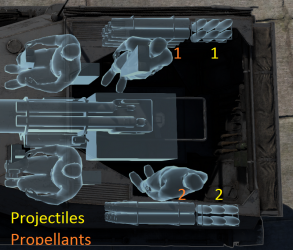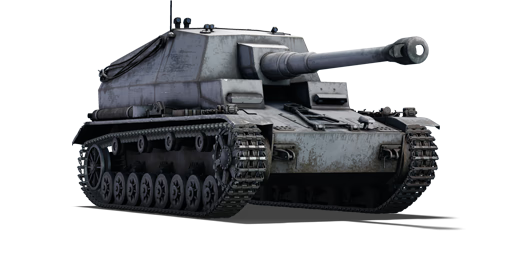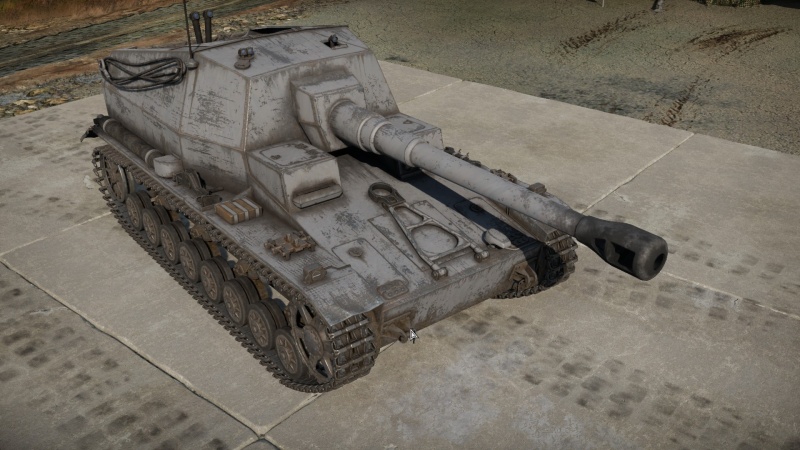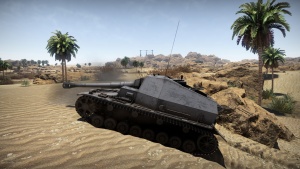Difference between revisions of "Dicker Max"
(→Mobility) (Tag: Visual edit) |
(→Modifications and economy) (Tag: Visual edit) |
||
| Line 41: | Line 41: | ||
=== Modifications and economy === | === Modifications and economy === | ||
| − | {{Specs-Economy}} | + | {{Specs-Economy}}For a newly purchased stock Dicker Max, consider unlocking all mobility midifications first. Because its sluggishness is its biggest enemy, the Dicker Max can often lose the chance of firing simply because it cannot turn its hull quickly/climb up a small slope in time. This is more noticeable when the Dicker Max is getting flanked/circled. Even a heavy tank like [[M6A1]] can easily drive around a stock Dicker Max and avoid its gun. |
| + | |||
| + | The next modifications to research can be the gun aiming drives, to speed up the targeting process as well as enhancing the accuracy of the cannon. This is critical for a sniper like Dicker Max as it relies on precision at long ranges. | ||
| + | |||
| + | Other modifications like Parts, FPE and Pzgr.rot may not as important. Remember, given the bad armour and mobility, the Dicker Max will not survive long upon getting spotted and hit, thus reparing/putting out fires may not help at all. The stock shell is already lethal for common opponents such as [[T-34 (Family)|T-34]] and [[M4]], the researchable round is only useful against heavy targets like [[M4A3E2]]. | ||
== Armaments == | == Armaments == | ||
Revision as of 02:03, 13 April 2021
Contents
Description
The 10.5cm K18 Pz.Sfl.IVa "Dicker Max" is a rank II German tank destroyer with a battle rating of 4.0 (AB) and 3.7 (RB/SB). It was introduced in Update 1.57 "Battle March".
The Dicker Max is a open-topped SPG with a 105 mm (10.5 cm) cannon, based on the Pz.IV E chassis. The 10.5 cm artillery gun is not only more effective than the StuH's 10.5 cm howitzer, but it is very consistent in terms of the results: hits that usually devastate the enemy. Its 14 second reload is not bad either, for a gun of its size, 4 seconds faster than the StuH, and over twice as fast as the KV-2's. The 105 mm HE round can also be effective on many lightly armoured vehicles like the M18 Hellcat.
General info
Survivability and armour
The survivability of the Dicker Max is very inadequate. The all-round armour is very thin and poorly angled, varying from 50mm to 20mm, which is not enough to stop any rounds other than rifle-caliber bullets. Post-penetration survivability is bad, crew members or critical components (eg. gun breech, engine) will usually get destroyed, crippling the tank. It is also open topped, meaning any plane with a gun can kill you. Fire from above will usually hurt or knock out all your crews, or damage/destroy exposed modules like gun breech and ammo. Common aircraft like the P-47 can do this in just a few seconds with machine guns alone. The only plus side is perhaps that the 5 crew members are spread out on the hull sides, meaning it might take a few shots to destroy the Dicker Max using solid shots (eg. Sherman Firefly). Unfortunately vehicles firing explosive-packed shells (eg. ISU-152) still have no problem one-shotting the Dicker Max. Therefore, you not only have to avoid ground vehicles, threats from the sky must also be considered, which makes the Dicker Max a challenge to play.
Armour type:
- Rolled homogeneous armour
| Armour | Front (Slope angle) | Sides (Slope angle) | Rear (Slope angle) | Roof |
|---|---|---|---|---|
| Hull | 12 mm (77°) Front glacis 50 mm (20°) Lower glacis 50 mm (14°) Driver ports |
20 mm | 20 mm (9°) | 12 mm |
| Superstructure | 30 mm (14°) Front 50 mm (16°) Gun mantlet |
20 mm (21°) | 20 mm (9-17°) | 10 mm |
Notes:
- Suspension wheels are 15 mm thick and tracks are 20 mm thick.
- The roof of the superstructure does not fully cover the top, thus still exposing the crew members.
Mobility
| Game Mode | Max Speed (km/h) | Weight (tons) | Engine power (horsepower) | Power-to-weight ratio (hp/ton) | |||
|---|---|---|---|---|---|---|---|
| Forward | Reverse | Stock | Upgraded | Stock | Upgraded | ||
| Arcade | 31 | 6 | 21 | 256 | 343 | 12.19 | 16.33 |
| Realistic | 28 | 6 | 159 | 180 | 7.57 | 8.57 | |
Modifications and economy
The next modifications to research can be the gun aiming drives, to speed up the targeting process as well as enhancing the accuracy of the cannon. This is critical for a sniper like Dicker Max as it relies on precision at long ranges.
Other modifications like Parts, FPE and Pzgr.rot may not as important. Remember, given the bad armour and mobility, the Dicker Max will not survive long upon getting spotted and hit, thus reparing/putting out fires may not help at all. The stock shell is already lethal for common opponents such as T-34 and M4, the researchable round is only useful against heavy targets like M4A3E2.
Armaments
Main armament
| 105 mm K.18 | Turret rotation speed (°/s) | Reloading rate (seconds) | |||||||||||
|---|---|---|---|---|---|---|---|---|---|---|---|---|---|
| Mode | Capacity | Vertical | Horizontal | Stabilizer | Stock | Upgraded | Full | Expert | Aced | Stock | Full | Expert | Aced |
| Arcade | 26 | -15°/+10° | ±8° | N/A | 10.6 | 14.6 | 17.8 | 19.6 | 20.9 | 16.90 | 14.95 | 13.78 | 13.00 |
| Realistic | 7.1 | 8.4 | 10.2 | 11.3 | 12.0 | ||||||||
Ammunition
| Penetration statistics | |||||||
|---|---|---|---|---|---|---|---|
| Ammunition | Type of warhead |
Penetration @ 0° Angle of Attack (mm) | |||||
| 10 m | 100 m | 500 m | 1,000 m | 1,500 m | 2,000 m | ||
| PzGr | APHE | 155 | 153 | 144 | 133 | 123 | 114 |
| Gr.19 | HE | 23 | 23 | 23 | 23 | 23 | 23 |
| Pzgr.rot | APCBC | 187 | 184 | 174 | 162 | 151 | 141 |
| Shell details | |||||||||
|---|---|---|---|---|---|---|---|---|---|
| Ammunition | Type of warhead |
Velocity (m/s) |
Projectile Mass (kg) |
Fuse delay (m) |
Fuse sensitivity (mm) |
Explosive Mass (TNT equivalent) (g) |
Ricochet | ||
| 0% | 50% | 100% | |||||||
| PzGr | APHE | 822 | 14 | 1.2 | 19 | 238 | 47° | 60° | 65° |
| Gr.19 | HE | 835 | 15.1 | 0 | 0.1 | 1,850 | 79° | 80° | 81° |
| Pzgr.rot | APCBC | 822 | 15.56 | 1.2 | 19 | 357.5 | 48° | 63° | 71° |
Ammo racks

| Full ammo |
Ammo part |
1st rack empty |
2nd rack empty |
Visual discrepancy |
|---|---|---|---|---|
| 26 | Projectiles Propellants |
14 (+12) 14 (+12) |
1 (+25) 1 (+25) |
Yes |
Usage in battles
As with any open-topped SPGs (such as the Marder IIIs), this is not a vehicle to charge the opponent with. However, one that can very effective at long ranges and from behind cover. An alternative play style for these vehicle in a closer range is supporting standard tanks by watching their flanks. It is NOT a fast vehicle, especially in realistic and simulator battles, but once it finds a place to stop and take aim, its gun is a very, very efficient anti-tank weapon, comparable to that of the mighty KV-2 turreted assault gun. Its most notable feature is its extreme gun depression, over -15° to +10°, which allows this tank to take advantage of great hull-down positions behind hills, becoming near-invisible in RB and SB at distance. Its weakness however, is rather obvious: the crew compartment is thinly armoured, which means basically anything can penetrate it can cause havoc for the tank commander and his crew. Combined with its slow acceleration, this is a vehicle to be used in a tactical manner in both offensive or usually, defensive combat.
With only 50 mm of armour at a battle rating of 4.3, the Dicker Max can be defeated frontally by any vehicle of its rank, even at some range. It is particularly vulnerable to SPAAs with a high rate of fire (heavy machine guns can penetrate the rear, or shoot down into the cabin should the opportunity present itself) and large-calibre shells. Airplanes are also devastating, especially if they are full of guns. Artillery is also worth noting.
Pros and cons
Pros:
- Excellent penetration and damage with both stock and researchable rounds. Easily one-shots even the heaviest target like M4A3E2 and IS-1
- One of the best gun depression (-15°) allows it to adapt any terrains with great ease and hide behind hills
- Outstanding gunsight zoom (9x) meaning it can comfortably engage targets from long range, thus protecting itself
- Adequate reload speed for its caliber
- 5 crew members are spread out along the sides, meaning it is hard to get one-shot killed by average ammo
- Easily camoflaged when hull down
Cons:
- Terrible mobility regardless of road quality: slow top speed, absymal hull traverse, poor reverse, sluggish acceleration. Responds slowly to fast targets like M22
- Rather limited horizontal gun traverse of 16°
- Inadequate gun elevation of only 10°, meaning it cannot target properly when the opponent is above the Dicker Max
- No armour protection: low thickness around the vehicle. Can get penetrated by any gun
- Open-topped design makes it very vulnerable for strafing aircraft
- Stock shells tend to ricochet on rounded armour (eg. turret cheeks of IS-1)
- Shell drop is quite noticeable, plus the slow velocity, long range sniping can take time to get used to
- Large side profile
History
Development
The role of the "assault gun" in the German army in World War II gave the infantry an upper hand in assaulting fortification. However, heavy bunkers could withstand large punishment from artillery and closing up to the bunker for a closer shot exposed the assault guns and artilleries to defensive artillery weapon. A weapon was needed to fight bunkers at an extreme range that the bunkers and other defensive weaponry would not be able to return fire, something with a very heavy gun to destroy these bunkers. Krupp began development of such a vehicle in 1939, but such a vehicle soon became unnecessary with the conclusion of the Battle of France. Thus, the project shifted from a heavy "assault gun" to a tank destroyer. Two of these vehicles were built in January 1941 and were presented to Hitler in March 1941. It was hoping that if proved favorable, the vehicle would be able to be put into service and production by Spring 1942.
Design
The vehicle design during its development was called the 10 cm K. (Pz. Sfl. IVa) and the 10.5 cm K (gp.Sfl.). Another name it was called was Dicker Max (Thick or Fat Max). The design took a Panzer IV Ausf. E chassis and removed the turret to add an open-topped superstructure on top to hold the heavy 10.5 cm gun. The design had armour around 50 mm in the front angled at 15 degrees. Armoured compartments were present in the vehicle rear to protect loaders from overhead attacks. The front has a false driver port present on the right side of the vehicle with the real one on the left, whether it was there to deceive enemy fire or simply a design oversight is unknown. The commander, gunner, and loaders all have their own sights available to them to observe the landscape for targets. The engine is the 180 hp Inline-6 Maybach HL66P. Though the prototype vehicles used the Panzer IV as the basis, it is predicted that in production, the vehicle would use the Panzer III instead due to increased mobility of the suspension and running gear.
Combat usage
Trials with the two prototypes Krupp produced were done by Anti-tank Battalion 521. The battalion took the vehicles with them during Operation Barbarossa. One was destroyed due to catching fire and an ammunition explosion, but the other was able to last until the end of 1941.The sole vehicle also saw use in the German offensive Case Blue in Summer 1942, but it was not reported to be operational by the battalion afterwards. Opinion of the vehicle was that it was unsuitable for participation in a frontal assault due to its low armour and manoeuvrability. The gun was deemed effective in supporting an infantry assault and knocking out tanks, but the heavy muzzle blast caused large dust to obscure the gunner view, requiring an observer to watch where the shots land. No reports were made on engine and transmission problems, but there were issues with the brake system. Due to these issues, the Dicker Max did not see mass production for widespread usage. Thus, only the two prototypes were made before interest in the project dropped.
Media
- Skins
- Images
- Videos
See also
Links to the articles on the War Thunder Wiki that you think will be useful for the reader, for example:
- reference to the series of the vehicles;
- links to approximate analogues of other nations and research trees.
External links
| Germany tank destroyers | |
|---|---|
| Pz. I Derivatives | Panzerjäger I |
| Pz. II Derivatives | 15cm sIG 33 B Sfl |
| Pz. 38(t) Derivatives | Marder III · Marder III H · Jagdpanzer 38(t) |
| Pz. III Derivatives | StuG III A · StuG III F · StuG III G · StuH 42 G |
| Pz. IV Derivatives | Jagdpanzer IV · Panzer IV/70(A) · Panzer IV/70(V) · Dicker Max · Nashorn · Brummbär · VFW |
| Pz. V Derivatives | Jagdpanther G1 · Bfw. Jagdpanther G1 |
| Pz. VI Derivatives | Sturer Emil · Elefant · Ferdinand · 38 cm Sturmmörser · Jagdtiger |
| Wheeled/Half-track | 8,8 cm Flak 37 Sfl. · Sd.Kfz.251/9 · Sd.Kfz.251/10 · Sd.Kfz.251/22 · Sd.Kfz.234/3 · Sd.Kfz.234/4 · 15 cm Pz.W.42 |
| ATGM Carrier | RakJPz 2 · RakJPz 2 (HOT) · Wiesel 1A2 |
| Other | Waffenträger · M109G · JPz 4-5 · Raketenautomat · VT1-2 |






